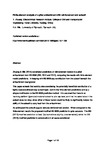Finite-element analysis of a piled embankment with reinforcement and subsoil
| dc.contributor.author | Zhuang, Y | |
| dc.contributor.author | Ellis, EA | |
| dc.date.accessioned | 2016-07-13T12:50:28Z | |
| dc.date.available | 2016-07-13T12:50:28Z | |
| dc.date.issued | 2016-07-01 | |
| dc.identifier.issn | 0016-8505 | |
| dc.identifier.issn | 1751-7656 | |
| dc.identifier.uri | http://hdl.handle.net/10026.1/5054 | |
| dc.description.abstract |
<jats:p> In 2014, the authors of this paper considered predictions of reinforcement tension in a piled embankment from British standard BS 8006 published in 2010 and the 2012 amended version, and compared the results with finite-element model predictions. In keeping with BS 8006, any contribution from the subsoil beneath the embankment was ignored. The present paper extends that earlier work by also considering the potentially beneficial contribution of a lightly overconsolidated clay subsoil layer, both in the finite-element predictions and as a simple modification to the BS 8006 predictive method. It is assumed that there is no ‘working platform’ (granular) material below the pile cap level, and that the water table in the subsoil does not drop, since either of these factors would be likely to significantly reduce the ability of the subsoil to carry load from the embankment. As anticipated, the subsoil support reduces reinforcement tension. When compared to the finite-element results the proposed modified BS 8006 prediction is quite accurate. The BSI 2012 modified prediction is ‘best’ (but sometimes slightly unconservative), whereas the BSI 2010 modified prediction is conservative in all cases considered. </jats:p> | |
| dc.format.extent | 596-601 | |
| dc.language | en | |
| dc.language.iso | en | |
| dc.publisher | Thomas Telford Ltd. | |
| dc.subject | embankments | |
| dc.subject | finite-element modelling | |
| dc.subject | geosynthetics | |
| dc.title | Finite-element analysis of a piled embankment with reinforcement and subsoil | |
| dc.type | journal-article | |
| dc.type | Journal Article | |
| plymouth.author-url | https://www.webofscience.com/api/gateway?GWVersion=2&SrcApp=PARTNER_APP&SrcAuth=LinksAMR&KeyUT=WOS:000377361700007&DestLinkType=FullRecord&DestApp=ALL_WOS&UsrCustomerID=11bb513d99f797142bcfeffcc58ea008 | |
| plymouth.issue | 7 | |
| plymouth.volume | 66 | |
| plymouth.publication-status | Published | |
| plymouth.journal | Géotechnique | |
| dc.identifier.doi | 10.1680/jgeot.15.P.139 | |
| plymouth.organisational-group | /Plymouth | |
| plymouth.organisational-group | /Plymouth/Faculty of Science and Engineering | |
| plymouth.organisational-group | /Plymouth/Faculty of Science and Engineering/School of Engineering, Computing and Mathematics | |
| plymouth.organisational-group | /Plymouth/Users by role | |
| plymouth.organisational-group | /Plymouth/Users by role/Academics | |
| dcterms.dateAccepted | 2016-02-12 | |
| dc.rights.embargodate | 2017-6-3 | |
| dc.identifier.eissn | 1751-7656 | |
| dc.rights.embargoperiod | Not known | |
| rioxxterms.versionofrecord | 10.1680/jgeot.15.P.139 | |
| rioxxterms.licenseref.uri | http://www.rioxx.net/licenses/all-rights-reserved | |
| rioxxterms.licenseref.startdate | 2016-07-01 | |
| rioxxterms.type | Journal Article/Review |


